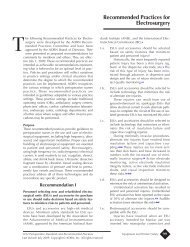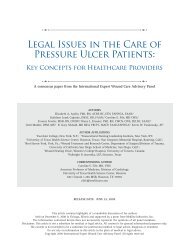2009 CAUTI guidelines - Centers for Disease Control and Prevention
2009 CAUTI guidelines - Centers for Disease Control and Prevention
2009 CAUTI guidelines - Centers for Disease Control and Prevention
Create successful ePaper yourself
Turn your PDF publications into a flip-book with our unique Google optimized e-Paper software.
an "uncertain trade off" between benefits <strong>and</strong> harms, then a "No Recommendation" was<strong>for</strong>mulated to reflect this uncertainty.Table 4. Formulating RecommendationsWeighing Benefits <strong>and</strong>HICPAC Recommendation Harms <strong>for</strong> CriticalOutcomesSTRONG (I)WEAK (II)Interventions with net benefitsor net harmsInteventions with trade offsbetween benefits <strong>and</strong> harmsQuality of EvidenceIA – High to ModerateIB – Low orVery Low (AcceptedPractice)IC – High to Very Low(Regulatory)High to Very LowNo recommendation/unresolved issueUncertain trade offs betweenbenefits <strong>and</strong> harmsLow to Very LowFor Category I recommendations, levels A <strong>and</strong> B represent the quality of the evidenceunderlying the recommendation, with A representing high to moderate quality evidence <strong>and</strong> Brepresenting low quality evidence or, in the case of an established st<strong>and</strong>ard (e.g., aseptictechnique, education <strong>and</strong> training), very low quality to no evidence based on our literaturereview. For IB recommendations, although there may be low to very low quality or even noavailable evidence directly supporting the benefits of the intervention, the theoretical benefitsare clear, <strong>and</strong> the theoretical risks are marginal. Level C represents practices required by stateor federal regulation, regardless of the quality of evidence. It is important to note that thestrength of a Category IA recommendation is equivalent to that of a Category IB or ICrecommendation; it is only the quality of the evidence underlying the IA recommendation thatmakes it different from a IB.In some instances, multiple recommendations emerged from a single narrative evidencesummary. The new HICPAC categorization scheme <strong>for</strong> recommendations is provided in Table1, which is reproduced below.Table 1. Modified HICPAC Categorization Scheme <strong>for</strong> RecommendationsCategory IAA strong recommendation supported by high to moderate quality evidencesuggesting net clinical benefits or harmsCategory IBA strong recommendation supported by low quality evidence suggestingnet clinical benefits or harms or an accepted practice (e.g., aseptictechnique) supported by low to very low quality evidenceCategory IC A strong recommendation required by state or federal regulation.Category IIA weak recommendation supported by any quality evidence suggesting atrade off between clinical benefits <strong>and</strong> harmsNo recommendation/ Unresolved issue <strong>for</strong> which there is low to very low quality evidence withunresolved issue uncertain trade offs between benefits <strong>and</strong> harms31
















